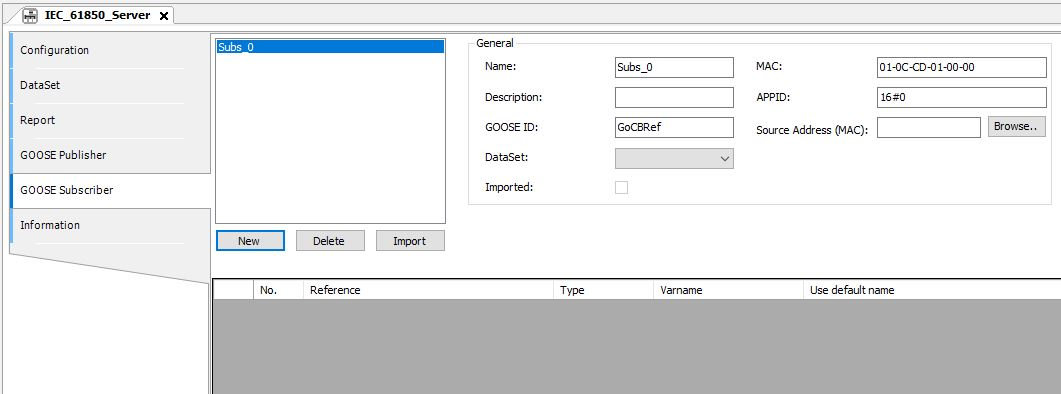In the tab “ GOOSE Subscriber” of the IEC 61850 editor you make settings for the receiving of GOOSE messages.





NOTICE

The order of the attributes of a “DataSet” is important for the receiving and the sending of GOOSE messages. Type and order of the entries from sender and recipient must be identical for GOOSE communication.




NOTICE

To receive a GOOSE message from an IED, sender and recipient must have the identical settings in the following input fields:
-
“APPID”
-
“GOOSE ID”
-
“DataSet” structure (with regard to order and data type of the attributes).
Sections of this tab:
List of the GOOSE control blocks in the left part.
Buttons:
-
[New]: Create a new GOOSE control block.
-
[Delete]: Delete the selected GOOSE control block.
-
[Import]: Import a GOOSE control block in the SCL format.
General settings in the top middle part:
|
Setting |
Description |
|---|---|
|
Name |
Name of the GOOSE control block, editable. |
|
Description |
Description of the GOOSE control block. |
|
GOOSE ID |
Unique character string of the GOOSE control block, editable. |
|
DataSet |
Data set sent as a GOOSE message. |
|
MAC |
Multicast addressing Multicast addressing is used to send GOOSE messages. Addressing allows an entire group of devices to exchange data with each other. Requirement: Unique address allocation of the different device groups. Valid range of values: 01-0C-CD-01-00-00....01-0C-CD-01-01-FF |
|
APPID |
Application-ID Number for the system-wide unique identification of a GOOSE control block. To exchange GOOSE telegrams, this number must be identical for sender and recipient. Valid range of values: 0 ... 4095 |
|
Source Address (MAC) |
[Browse...] button: Looks for an Ethernet port in the network. Requirement - an existing network path to the PLC. |
List to assign GOOSE messages to global variables in the bottom right part.
All attributes within the selected data set are listed in this list. You can assign incoming GOOSE messages to global CODESYS variables. For this, select the desired attribute in the list and edit the name of a global variable in the “Varname” column. If you edit a new variable name a global variable will be created, if you activate the “Use default name” checkbox, a variable name is generated automatically. This variable will be written by incoming GOOSE messages.
The variables will be stored “IEC61850_Generated_GVL” (of the “IEC61850 Generated POUs” folder) after generating the code of the “IEC 61850 Server”.






